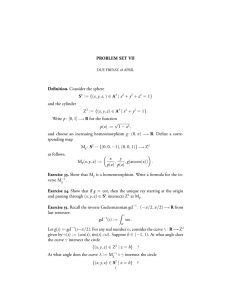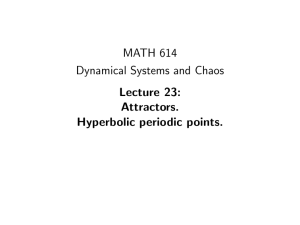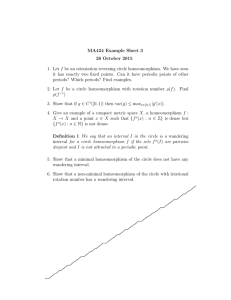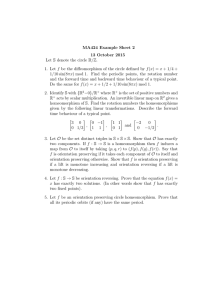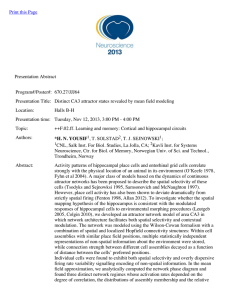Loosely, the question is whether the dynamics on a finite-dimensional
advertisement
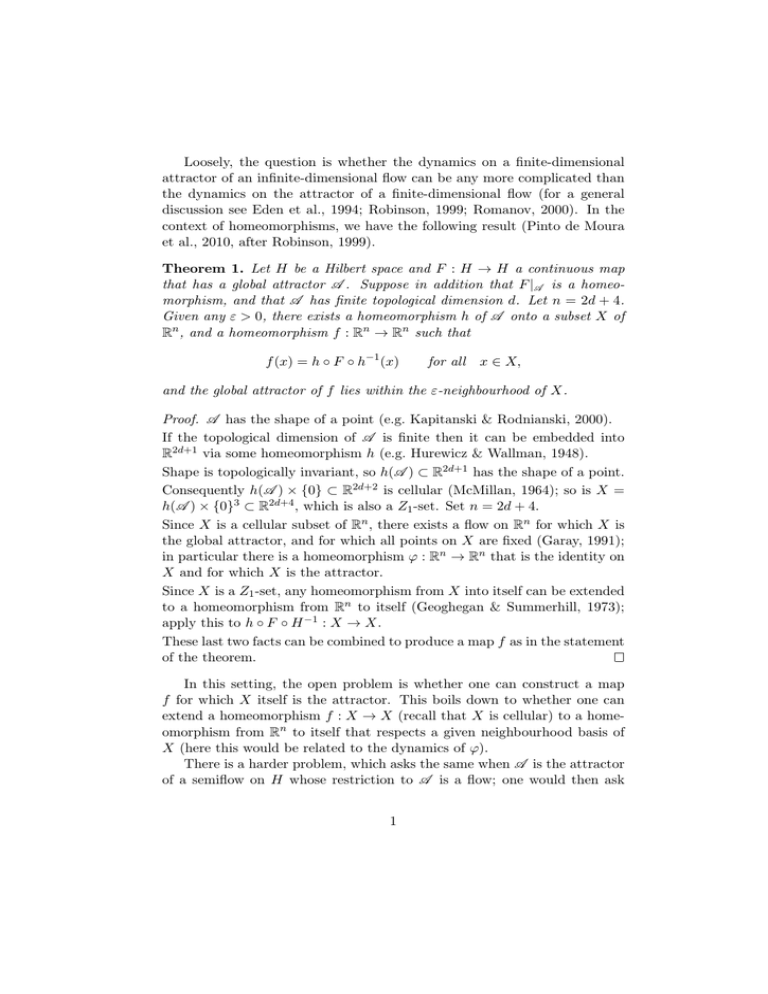
Loosely, the question is whether the dynamics on a finite-dimensional
attractor of an infinite-dimensional flow can be any more complicated than
the dynamics on the attractor of a finite-dimensional flow (for a general
discussion see Eden et al., 1994; Robinson, 1999; Romanov, 2000). In the
context of homeomorphisms, we have the following result (Pinto de Moura
et al., 2010, after Robinson, 1999).
Theorem 1. Let H be a Hilbert space and F : H → H a continuous map
that has a global attractor A . Suppose in addition that F |A is a homeomorphism, and that A has finite topological dimension d. Let n = 2d + 4.
Given any ε > 0, there exists a homeomorphism h of A onto a subset X of
Rn , and a homeomorphism f : Rn → Rn such that
f (x) = h ◦ F ◦ h−1 (x)
for all
x ∈ X,
and the global attractor of f lies within the ε-neighbourhood of X.
Proof. A has the shape of a point (e.g. Kapitanski & Rodnianski, 2000).
If the topological dimension of A is finite then it can be embedded into
R2d+1 via some homeomorphism h (e.g. Hurewicz & Wallman, 1948).
Shape is topologically invariant, so h(A ) ⊂ R2d+1 has the shape of a point.
Consequently h(A ) × {0} ⊂ R2d+2 is cellular (McMillan, 1964); so is X =
h(A ) × {0}3 ⊂ R2d+4 , which is also a Z1 -set. Set n = 2d + 4.
Since X is a cellular subset of Rn , there exists a flow on Rn for which X is
the global attractor, and for which all points on X are fixed (Garay, 1991);
in particular there is a homeomorphism ϕ : Rn → Rn that is the identity on
X and for which X is the attractor.
Since X is a Z1 -set, any homeomorphism from X into itself can be extended
to a homeomorphism from Rn to itself (Geoghegan & Summerhill, 1973);
apply this to h ◦ F ◦ H −1 : X → X.
These last two facts can be combined to produce a map f as in the statement
of the theorem.
In this setting, the open problem is whether one can construct a map
f for which X itself is the attractor. This boils down to whether one can
extend a homeomorphism f : X → X (recall that X is cellular) to a homeomorphism from Rn to itself that respects a given neighbourhood basis of
X (here this would be related to the dynamics of ϕ).
There is a harder problem, which asks the same when A is the attractor
of a semiflow on H whose restriction to A is a flow; one would then ask
1
for a flow on Rn for which X = h(A ) is the global attractor, on which the
dynamics is conjugate to those of the original semiflow on A . In this version
even the ‘attractor within ε’ version of the result is unknown. It would thus
be interesting to have a ‘flow extension’ theorem, i.e. what properties of
X ⊂ Rn ensure that any flow on X can be extended to a flow on Rn ?
The motivating problem behind this appears to be even harder. Global
(A,)
attractors with finite box-counting dimension dB (A ) = lim sup→0 log−Nlog
,
with N (A, ) is the minimum number of balls required to cover A , arise
for the semigroups generated by various dissipative parabolic PDEs, most
notably the 2D incompressible Navier–Stokes equations (see Temam, 1988,
for example). One can show (following an argument of Kukavica, 2007)
that on these attractors the underlying PDE can be written as an infinitedimensional ODE u̇ = F (u), where F is 1-log-Lipschitz on A , i.e.
|F (u) − F (v)| ≤ C|u − v| log(R/|u − v|)
for all
u, v ∈ A .
(2)
Ideally in this case one would construct an ODE on Rn for which X
(the embedded version of A ) is an invariant set, or better still the global
attractor. This involves extending the embedded vector field h ◦ F ◦ h−1
n
from X to a vector field f on
uniqueness of ẋ = f (x) when |f (x) −
R 1 R ; since
−1
f (y)| ≤ ω(|x − y|) requires 0 ω(r) dr = ∞, one would like f to be at least
1-log-Lipschitz. But given (2) this would require h (the homeomorphism
from A onto X) to be bi-Lipschitz, which is extremely strong and unlikely
to be true in general; conditions guaranteeing that an arbitrary compact
subset of a Hilbert space can be embedded in a bi-Lipschitz way into some
Rn are not known.
When dB (A ) = d and A is the attractor of an equation like (1), it is
known that if k > 2d then ‘most’ linear maps from H into Rk have a Hölder
continuous inverse (Hunt & Kaloshin, 1999). But this is not sufficient for
uniqueness of the embedded ODE. If dA (A − A ) = d, where dA is the
Assouad dimension,
dA (X) = inf{s : N (A ∩B(x, ρ), r) ≤ M (r/ρ)s for some M > 0, for all ρ < r},
then it is known that ‘most’ linear maps from H into Rk are α-log-Lipschitz
with α > (k + 2)/2(k − d) (Robinson, 2011; after Olson & Robinson, 2010).
But (i) there is no known method for showing that the attractors of PDEs
satisfy dA (A − A ) < ∞, and (ii) even coupled with (2) such smoothness of
L−1 is not sufficient to guarantee uniqueness of the embedded vector field
(which could be made almost 3/2-log-Lipschitz).
2
How to carry forward the programme in this continuous case is a mystery.
How to improve (2) is unclear; and it is known that the exponent 1/2 in (3)
is sharp in general (Pinto de Moura & Robinson, 2010).
References
A Eden, C Foias, B Nicolaenko, & R Temam (1994) Exponential attractors
for dissipative evolution equations (Wiley, New York).
B M Garay (1991) Strong cellularity and global asymptotic stability. Fund.
Math. 138, 147–154.
R Geoghegan & R R Summerhil (1973) Concerning the shapes of finitedimensional compacta. Trans. Amer. Math. Soc. 179, 281–292.
B R Hunt & V Y Kaloshin (1999) Regularity of embeddings of infinitedimensional fractal sets into finite-dimensional spaces. Nonlinearity 12,
1263–1275.
W Hurewicz & H Wallman (1948) Dimension Theory. Princeton University
Press.
L Kapitanski & I Rodnianski (2000) Shape and Morse Theory of Attractors.
Comm. Pure Appl. Math. 53, 218–242.
I Kukavica (2007) Log-log convexity and backward uniqueness. Proc. Amer.
Math. Soc. 135, 2415–2421.
D R McMillan (1964) A criterion for cellularity in a manifold. Ann. of Math.
79, 327–337.
E J Olson & J C Robinson (2010) Almost bi-Lipschitz embeddings and
almost homogeneous sets. Trans. Amer. Math. Soc. 362, 145–168.
E Pinto de Moura & J C Robinson (2010) Orthogonal sequences and regularity of embeddings into finite-dimensional spaces. J. Math. Anal. Appl.
368, 254–262.
E Pinto de Moura, J C Robinson, & J J Sánchez-Gabites (2010) Embedding
of global attractors and their dynamics, Proc. Amer. Math. Soc., to appear.
J C Robinson (1999) Global Attractors: Topology and finite-dimensional
dynamics. J. Dynam. Differential Equations 11, 557–581.
J C Robinson (2011) Dimensions, Embeddings, and Attractors. Cambridge
University Press.
A V Romanov (2000) Finite-dimensional limiting dynamics for dissipative
parabolic equations. Math. Sbornik 191, 415–429.
R Temam (1988) Infinite-dimensional dynamical systems in mechanics and
physics. Springer.
3
